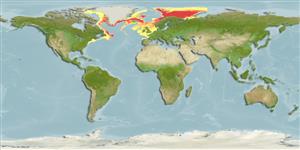Yoldiella lenticula (Moller, 1842)
Lenticulate yoldia| Native range | All suitable habitat | Point map | Year 2050 |

|
| This map was computer-generated and has not yet been reviewed. |
| Yoldiella lenticula AquaMaps Data sources: GBIF OBIS |
Google image | No image available for this species;
drawing shows typical species in Yoldiidae.
Classification / Names Populärnamn | synonymer | CoL | ITIS | WoRMS
Bivalvia | Nuculanida | Yoldiidae
Environment: milieu / climate zone / djupintervall / distribution range Ekologi
; djupintervall 1 - 1400 m (Ref. 119523). Polar; 84°N - 49°N, 169°W - 139°E
Distribution Länder | FAO områden | Ekosystem | Förekomster | Utplanteringar
Arctic, Northeast Pacific, and Northern Atlantic: from Alaska, Beaufort Sea, south to UK, east to Laptev Sea.
Length at first maturity / Size / Weight / Age
Könsmognad: Lm ? range ? - ? cm
Life cycle and mating behavior Könsmognad | Reproduktion | Lek | Eggs | Fecundity | Larvae
Main reference
referenser | Koordinator | Medarbetare
Piepenburg, D., N.V. Chernova, C.F. von Dorrien, J. Gutt, A.V. Neyelov, E. Rachor, L. Saldanha and M.K. Schmid 1996 Megabenthic communities in the waters around Svalbard. Polar Biol. 16:431-446. (Ref. 2952)
IUCN Red List Status
(Ref. 130435: Version 2025-1)
CITES status (Ref. 108899)
CMS (Ref. 116361)
Threat to humans
Human uses
| FishSource |
Verktyg
Ytterligare information
Födosammansättning
Födointag
Predatorer
Max. ages / sizes
Length-weight rel.
Length-length rel.
Length-frequencies
Mass conversion
Abundans
Internet-källor
BHL | BOLD Systems | CISTI | DiscoverLife | FAO(Publication : search) | Fishipedia | GenBank (genome, nucleotide) | GloBI | Gomexsi | Google Books | Google Scholar | Google | PubMed | Tree of Life | Wikipedia (Go, sök) | Zoological Record



